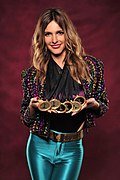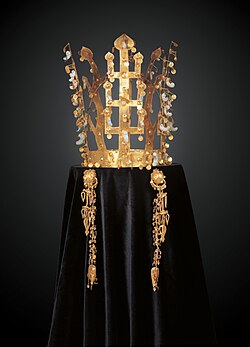Portal:Fashion
The Fashion Portal
 | |

| |
Fashion is a term used interchangeably to describe the creation of clothing, footwear, accessories, cosmetics, and jewellery of different cultural aesthetics and their mix and match into outfits that depict distinctive ways of dressing (styles and trends) as signifiers of social status, self-expression, and group belonging. As a multifaceted term, fashion describes an industry, designs, aesthetics, and trends.
The term 'fashion' originates from the Latin word 'Facere,' which means 'to make,' and describes the manufacturing, mixing, and wearing of outfits adorned with specific cultural aesthetics, patterns, motifs, shapes, and cuts, allowing people to showcase their group belongings, values, meanings, beliefs, and ways of life. Given the rise in mass production of commodities and clothing at lower prices and global reach, reducing fashion's environmental impact and improving sustainability has become an urgent issue among politicians, brands, and consumers. (Full article...)
Selected article -
Fashion is a 2008 Indian Hindi-language female empowerment drama film written and directed by Madhur Bhandarkar. The film stars Priyanka Chopra, Kangana Ranaut and Mugdha Godse in lead roles, with Arjan Bajwa, Samir Soni and Arbaaz Khan in supporting roles. The film's screenplay was co-written by Ajay Monga, Bhandarkar and Anuraadha Tewari. Principal photography took place in Mumbai and Chandigarh. Salim–Sulaiman composed the films soundtrack, with lyrics written by Irfan Siddiqui and Sandeep Nath. The film was made on a budget of ₹180 million (US$2.1 million).
The story revolves around Meghna Mathur, an aspiring fashion model; it follows her transformation from small-town girl to supermodel, the Indian fashion industry and the careers of several other models. Fashion also explores feminism and female power in Indian fashion. The cast also features several professional fashion models playing themselves. The film was a turning point in Chopra's career after several consecutive flops prior to this film. (Full article...)
Core topics -
The study of the history of clothing and textiles traces the development, use, and availability of clothing and textiles over human history. Clothing and textiles reflect the materials and technologies available in different civilizations at different times. The variety and distribution of clothing and textiles within a society reveal social customs and culture.
The wearing of clothing is exclusively a human characteristic and is a feature of most human societies. There has always been some disagreement among scientists on when humans began wearing clothes, but newer studies from The University of Florida involving the evolution of body lice suggest it started sometime around 170,000 years ago. The results of the UF study show humans started wearing clothes, a technology that allowed them to successfully migrate out of Africa. Anthropologists believe that animal skins and vegetation were adapted into coverings as protection from cold, heat, and rain, especially as humans migrated to new climates. Silk weaving began in India c. 400 AD; cotton spinning began in India c. 3000 BC. A recent archaeological excavation from Neolithic Mehrgarh revealed in the article Analysis of Mineralized Fibres from a Copper Bead, that cotton fibers were used in the Indus Valley c. 7000 BC. (Full article...)
Featured picture -

A photo of two maiko (apprentice geisha), with the typical make-up clearly visible, leaving portions of the nape uncovered. This is done to accentuate what is a traditionally erotic area. The white face make-up is supposed to resemble a mask, and a line of bare skin around the hairline helps create that illusion. Established geisha generally wear full white face makeup characteristic of maiko only during special performances.
Did you know... -
- ... that the white dress that Marilyn Monroe wore in the 1955 film The Seven Year Itch (pictured) is up for auction today and may fetch up to two million US dollars?
- ... that the wedding dress of Lady Diana Spencer became one of the most famous outfits in the world and featured a 25-foot (7.6 m) train?
- ... that Clare Potter was one of the first fashion designers in the United States to be known by name and is credited with inventing American sportswear?
Selected biography -
Victoria Caroline, Lady Beckham (née Adams; born 17 April 1974), is an English fashion designer, singer, and television personality. She rose to prominence in the 1990s as a member of the pop group the Spice Girls, in which she was nicknamed Posh Spice. After the Spice Girls disbanded in 2001, Beckham signed with Virgin Records, to release her self-titled debut solo album, which produced two UK Top 10 singles. Beckham has also become an internationally recognised style icon and fashion designer.
Beckham has starred in five official documentaries and reality shows, including Victoria's Secrets (2000), Being Victoria Beckham (2002), The Real Beckhams (2003), Victoria Beckham – A Mile in Their Shoes (2004), and Victoria Beckham: Coming to America (2007). She is married to former association football player Sir David Beckham, and they have four children, including Brooklyn and Romeo. As of May 2019, the couple's joint wealth is estimated at £355 million. (Full article...)
General images
Lua error: No content found on page "Women's beachwear fashion".
More Did you know (auto generated)

- ... that a political action committee paid $132,000 to former First Lady Melania Trump's fashion stylist for strategy consulting?
- ... that The Horn of Plenty by Alexander McQueen satirized the fashion industry with clothing sewn from expensive fabric made to look like household trash?
- ... that before his victory at the 1128 Battle of Axspoele, William Clito ordered his knights to cut their hair and remove opulent clothing as a sign of penance?
- ... that across his thirty-six collections, fashion designer Alexander McQueen contemplated religion, told fairy tales, and criticized the fashion industry?
- ... that Eenoolooapik fell ill while kayaking through Aberdeen in traditional Inuit clothing?
- ... that during the Second World War, the British government's campaign Make-Do and Mend encouraged the public to fashion men's clothes into womenswear?
Selected quote -
Related portals
Topics
Featured content
Categories
Things you can do
- Fill out the red links on Portal:Fashion/Selected anniversaries
Wikimedia
The following Wikimedia Foundation sister projects provide more on this subject:
-
Commons
Free media repository -
Wikibooks
Free textbooks and manuals -
Wikidata
Free knowledge base -
Wikinews
Free-content news -
Wikiquote
Collection of quotations -
Wikisource
Free-content library -
Wikiversity
Free learning tools -
Wiktionary
Dictionary and thesaurus






























